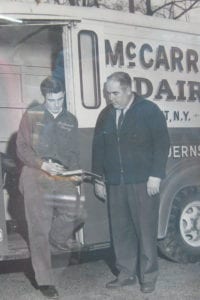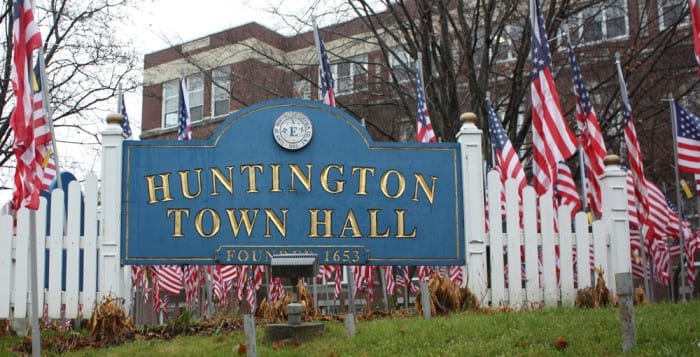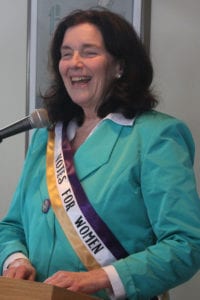For 71 years, McCarrick’s Dairy has been a staple for Rocky Point residents. So it was no surprise when owners Hugh McCarrick, Kevin McCarrick and Bridget Idtensohn announced through a social media post they were closing the store and selling the family business, the news spread rapidly, and was met by many with nostalgia and sadness.
On the morning of Friday, April 7, the last day before the sibling owners retired, friends and longtime patrons filled the store to remember old times, while flipping through photo albums.

Among those customers was Neil Maguire, who was having a bit of fun dressed in a cow costume while holding a double-sided sign that read: “McCarrick’s don’t close. Cows in protest. Cows in udder confusion” and “Cows in protest. Cows in disbelief. Don’t close.”
Maguire, who grew up in Port Jefferson, said he remembered when the McCarrick family would deliver milk to homes, and coming to the store with his family when the now-owners’ father Tom ran the small grocery.
“Mr. McCarrick would give us lollipops or a fruit juice to drink while my parents were running around shopping,” Maguire said.
He said it was McCarrick’s Dairy that inspired him to go into the milk delivery business, and he could always count on the family for advice.
Janice Bambara was disappointed that it would be her last day walking to the store for her morning coffee, preferring McCarrick’s over large chains like Dunkin’ Donuts or Starbucks.
“It was a very friendly and pleasant place to shop for so many years here,” she said. “They’ll all be missed.”
Kathy DiPierro, a cousin of the McCarricks, looked at the photo albums reminiscing about her grandparents homestead which once stood where McCarrick Medical Park is today. Her husband Nick, a former Grumman employee, remembered when he worked in the stores on Saturdays for a short period in 1969. He said the senior McCarrick was always generous and patient with him.
“I remember the first day he left me all by myself in that store,” DiPierro said. “He said, ‘It’s OK, this is how you work a cash register.’ I never worked a cash register. Boy, was I nervous.”

The goodbyes culminated when Brookhaven Town Councilwoman Jane Bonner (C-Rocky Point) and town Supervisor Ed Romaine (R) stopped by to present the family with a proclamation and declare April 7 McCarrick’s Dairy Day in the Town of Brookhaven.
While presenting the McCarricks with the proclamation, Bonner, who lives in the area and has known the family for nearly 30 years, had to hold back the tears. Like many who filled the store, while she was sad to see the store close, she was happy for the owners.
“It’s so great that they are leaving on their own terms to enjoy their retirement, not because they were forced out by a big box store or another chain store or supermarket,” Bonner said.
The owners said nearly 500 community members have worked in the store over the decades, and nearly half-a-dozen employees met their spouses there.
The McCarricks have been an integral part of the community.
The family has been part of the Miller Place-Rocky Point St. Patrick’s Day Parade since 1950, after Tom McCarrick and other local businessmen founded the Friends of St. Patrick not-for-profit organization that fundraises for the historic event. Kevin McCarrick, Tom’s son, also served two terms on the Brookhaven Town Board from 2004 to 2007.
Hugh, Kevin’s brother, said his grandparents emigrated from Ireland to Rocky Point in 1911. The couple had a few cows and grew vegetables on their homestead. It was in 1946 when his parents, Tom and Phyllis, decided to start a milk delivery business.
“It’s so great that they are leaving on their own terms to enjoy their retirement.”
— Jane Bonner
The land parcel, where the current McCarrick’s Dairy store was opened in 1984, holds many memories for the family. The house on the west side of the parking lot is where Tom and Phyllis raised nine children; the dry cleaners that sits toward the front was once an office and the original store that opened in 1960; and the thrift store toward the back of the parking lot was once a four-bay garage where the milk trucks were housed.
Hugh McCarrick said all of the children worked in the store at one point or another, and through the years every one of his children, nieces and nephews worked in the store.
“We grew up in the business working side by side with my dad and mom,” he said.
“We met in 1970, and he put me right to work,” his wife Miriam joked.
His older brothers delivered milk to homes, and later he and Kevin delivered to schools and local shops like bakeries. When they were in their early 20s, the two became more involved in the business.
But as times changed, the business changed.
“In the ’70s supermarkets started coming out, and families were having two cars,” Hugh McCarrick said. “So now the wife who stayed home, she had her newfound freedom, so she would go out and buy her own milk and stuff.”

One of Hugh’s earlier memories was when milk bottles would come back and still have milk left in them. They couldn’t be returned to the processing plant like that, so the children would clean them out. He said if there was sour milk in there, and you pushed down on the lid, it would shoot out.
“To this day I can’t eat cottage cheese,” he joked.
Despite the sour milk, the years working with his family have been positive ones. His brother agreed.
“We were very fortunate in that all of our family worked in this business from my older brothers right down to my younger sister, Bridget,” Kevin McCarrick said. “It was nice to have a family business that everyone participated in.”
Their sister, who started working at the store 35 years ago, said the outpouring of good wishes touched her.
“You go to work and you don’t think much about it,” she said. “To have everyone come here like this … this is such a wonderful, wonderful community.”
During the last week, she said she heard a number of heartwarming stories about her father.
“Your father delivered milk, eggs and butter to my house every day, and never charged us until my father got back on his feet,” she said one man told her. “I’m an adult now, and I realize how important that was.”

According to the McCarricks, the business will be leased to another food store and completely renovated. While they may be retiring from the store business, the owners will still manage the property.
As the store closed at 6 p.m. on its final day, former employees were invited to join the McCarricks for dinner. Family from near and far also gathered to bid farewell.
Hugh McCarrick’s daughter Kimmie Wheeler flew up from South Carolina the night before to be part of the store closing. She said she knew she needed to send off the store with her family.
“This is my whole life,” she said. “I started working here when I was a teenager and worked here with my cousins and my whole family. It was such a great way to be part of the family and the community.”
Her sister Kendra Beavis said the younger family members’ careers have taken different directions than their parents, becoming teachers, graphic designers, getting involved in law enforcement and various other things, but said she couldn’t picture anyone else taking the place of her father and the rest of the family.
“Even if someone were to take this over … they did such an amazing job,” she said. “I don’t know if anyone could ever fill their shoes.”






























